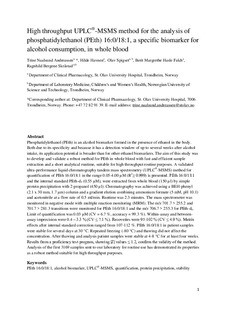| dc.contributor.author | Andreassen, Trine Naalsund | |
| dc.contributor.author | Havnen, Hilde | |
| dc.contributor.author | Spigset, Olav | |
| dc.contributor.author | Falch, Berit Margrethe Hasle | |
| dc.contributor.author | Skråstad, Ragnhild Bergene | |
| dc.date.accessioned | 2018-01-23T11:50:00Z | |
| dc.date.available | 2018-01-23T11:50:00Z | |
| dc.date.created | 2018-01-03T11:36:56Z | |
| dc.date.issued | 2017 | |
| dc.identifier.issn | 0146-4760 | |
| dc.identifier.uri | http://hdl.handle.net/11250/2479034 | |
| dc.description.abstract | Phosphatidylethanol (PEth) is an alcohol biomarker formed in the presence of ethanol in the body. Both due to its specificity and because it has a detection window of up to several weeks after alcohol intake, its application potential is broader than for other ethanol biomarkers. The aim of this study was to develop and validate a robust method for PEth in whole blood with fast and efficient sample extraction and a short analytical runtime, suitable for high throughput routine purposes. A validated ultra-performance liquid chromatography tandem mass spectrometry (UPLC®-MSMS) method for quantification of PEth 16:0/18:1 in the range 0.05–4.00 μM (R2 ≥ 0.999) is presented. PEth 16:0/18:1 and the internal standard (IS) PEth-d5 (0.55 μM), were extracted from whole blood (150 μL) by simple protein precipitation with 2-propanol (450 μL). Chromatography was achieved using a BEH-phenyl (2.1 × 30 mm, 1.7 μm) column and a gradient elution combining ammonium formate (5 mM, pH 10.1) and acetonitrile at a flow rate of 0.5 mL/min. Runtime was 2.3 min. The mass spectrometer was monitored in negative mode with multiple reaction monitoring (MRM). The m/z 701.7 > 255.2 and 701.7 > 281.3 transitions were monitored for PEth 16:0/18:1 and the m/z 706.7 > 255.3 for PEth-d5. Limit of quantification was 0.03 μM (coefficient of variation, CV = 6.7%, accuracy = 99.3%). Within-assay and between-assay imprecision were 0.4–3.3% (CV ≤ 7.1%). Recoveries were 95–102% (CV ≤ 4.9%). Matrix effects after IS correction ranged from 107% to 112%. PEth 16:0/18:1 in patient samples were stable for several days at 30°C. Repeated freezing (−80°C) and thawing did not affect the concentration. After thawing and analysis patient samples were stable at 4–8°C for at least 4 weeks. Results from a proficiency test program, showing |Z| values ≤1.2, confirm the validity of the method. Analysis of the first 3,169 samples sent to our laboratory for routine use has demonstrated its properties as a robust method suitable for high throughput purposes. | nb_NO |
| dc.language.iso | eng | nb_NO |
| dc.publisher | Oxford University Press (OUP) | nb_NO |
| dc.title | Hight throughput UHPC-MSMS method for the analysis of phosphatidylethanol (PEth) 16:0/18:1, a specific biomarker for alcohol consumption, in whole blood | nb_NO |
| dc.type | Journal article | nb_NO |
| dc.type | Peer reviewed | nb_NO |
| dc.description.version | acceptedVersion | nb_NO |
| dc.source.journal | Journal of Analytical Toxicology | nb_NO |
| dc.identifier.doi | 10.1093/jat/bkx075 | |
| dc.identifier.cristin | 1534611 | |
| dc.description.localcode | Postprint: This is a pre-copyedited, author-produced version of an article accepted for publication in [Journal of Analytical Toxicology following peer review. The version of record [insert complete citation information here] is available online at: [https://academic.oup.com/jat/advance-article/doi/10.1093/jat/bkx075/4103340]. Locked until 4.9.2018 due to copyright restrictions. | nb_NO |
| cristin.unitcode | 194,65,15,0 | |
| cristin.unitname | Institutt for klinisk og molekylær medisin | |
| cristin.ispublished | true | |
| cristin.fulltext | postprint | |
| cristin.qualitycode | 1 | |
